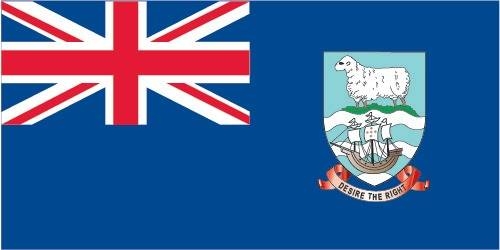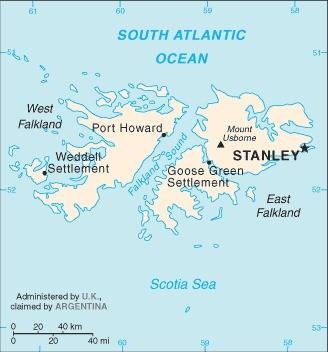120 Falkland Islands (UK)

Blue with the flag of the UK in the upper hoist-side quadrant and the Falkland Island coat of arms centered on the outer half of the flag. The coat of arms contains a white ram (sheep raising was once the major economic activity) above the sailing ship Desire (whose crew discovered the islands) with a scroll at the bottom bearing the motto DESIRE THE RIGHT.
Flag courtesy of the CIA World Factbook

Map courtesy of the CIA World Factbook

A Stanley shoreline view with a cruise ship in the background. Stanley is the only “city” on the islands (population about 2,100) and is the main shopping area.
Photo courtesy of the CIA World Factbook
Last updated on March 20, 2025
Government
According to Britannica, executive authority is vested in the British crown, and the islands’ government is headed by a governor appointed by the crown. As outlined in the Falkland Islands constitution (2009), the governor is advised by an Executive Council consisting of three of the elected members of the Legislative Assembly and two ex officio, nonvoting members (the chief executive and the director of finance). The governor presides over the Executive Council and must consult with it in the discharge of most of his or her duties but may, in certain circumstances, act against the advice of the council. The Legislative Assembly has 10 members, eight of whom are elected to four-year terms from two constituencies, while the other two, the same nonvoting members as on the Executive Council, are ex officio. Both the chief executive and the director of finance are appointed by the governor. There are no political parties, and all members of the legislature are elected as independents. The voting age is 18. The 2009 constitution provides the islands’ government with a greater degree of autonomy than the previous (1985) constitution, but the governor must consult with the regional commander of the British military on issues concerning defense and internal security.
Falkland Islands Civil Aviation Department (FICAD)
The Falkland Islands Civil Aviation Department (FICAD) is responsible for certain aspects of aviation regulatory oversight throughout the islands as designated by HE the Governor. Their small team of qualified staff are dedicated to ensuring that they meet their obligations regarding aviation regulation as set out in the designation instrument issued by HE the Governor. Aviation in the Falkland Islands has a number of stakeholders, and it is important to understand the various roles that each has and where responsibilities rest. It should be remembered at all times that all stakeholders should work within their remit towards continuous improvement in safety, and a more efficient and effective aviation sector. In the Falkland Islands regulation responsibility is designated by HE the Governor. Currently, designations have been made locally, where they are competent to do so, in the Director of Civil Aviation (DCA) or otherwise with Air Safety Support International (ASSI – the United Kingdom’s CAA subsidiary for British Overseas Territories). As competency to regulate additional designations is achieved they will be assigned to the DCA as a matter of policy.
ASSI has the responsibility of writing and maintaining both the enabling legislations (AN(OT)O – Air Navigation {Overseas Territories} Order) and the acceptable means of compliance with the Order (OTAR – Overseas Territories Aviation Requirements). It is important for the Regulator (each designation) to provide clear direction to industry on the AN(OT)O and the OTAR and to ensure, through an effective program of regulatory oversight, that the aviation industry operates in accordance with those instruments.
Airspace
SkyVector – Google Maps – ADS-B Exchange
ICAO countries publish an Aeronautical Information Publication (AIP). This document is divided into three parts: General (GEN), En Route (ENR) and Aerodromes (AD). ENR 1.4 details the types of airspace classes they chose to adopt from classes A through G.
Drone Regulations
ASSI – Legal requirements for the operation of small unmanned aircraft in the UK Overseas Territories
Advanced Air Mobility (AAM) Regulations & Policies
None found by the author.
However, should you, the reader, happen to stumble across something to the contrary, please email the author at FISHE5CA@erau.edu and you may be mentioned in the ACKNOWLEDGEMENTS section of this book by way of thanks for contributing to this free eBook!
Advanced Air Mobility (AAM) News
None found by the author.
However, should you, the reader, happen to stumble across something to the contrary, please email the author at FISHE5CA@erau.edu and you may be mentioned in the ACKNOWLEDGEMENTS section of this book by way of thanks for contributing to this free eBook!
Short Essay Questions
Scenario-Based Question
You have been hired by a Drone Startup Company. Your boss has immediately assigned this job to you.
They need you to prepare a one-page memo detailing the legalities of using a drone to film the shoreline in Stanley, pictured above.
They need you to mention any national laws and local ordinances.
They specifically want to know what airspace (insert pictures) you will be operating in and whether or not you need an airspace authorization.
Does it matter whether or not you are a citizen of the country?
Lastly, there is a bonus for you if, as you scroll through this chapter, you find any typos or broken links!
Short Essay Questions
- What are the drone categories?
- How is registration addressed?
- How is remote ID addressed?
- What are the model aircraft rules?
- What are the commercial drone rules?
- Are there waivers or exemptions to the rules? If so, for what?
- Would you share a link to an interactive airspace map?
- How is BVLOS addressed?
- How can you fly drones at night?
- How can you fly drones over people?
- Where do you find drone NOTAMs?
- What are the rules for drone maintenance?
- What are the rules for an SMS program?
- What are some unique rules not mentioned above?
- What are the C-UAS rules?
- What are the AAM rules?

